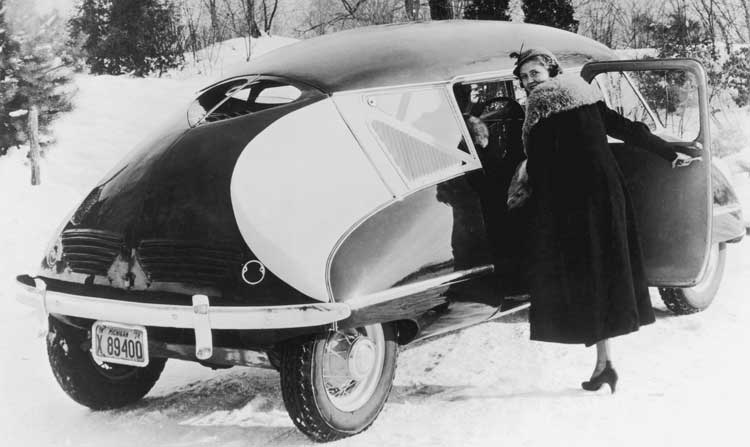Stout Scarab
The true pioneer thinking behind the MPV stretches back to 1935, says Giles Chapman

The MPV (multi-purpose or multi-passenger vehicle), people mover, people carrier - call it what you will - still seems novel enough to make its owners feel just that little bit smug about what they drive. After all, you have the towering visibility, the commanding driving position and, of course, the seats - plenty of them - seven, eight, even 11 in one, elephantine Korean newcomer. Yet it was, last month, exactly two decades ago that Renault defined the MPV genre.
The MPV (multi-purpose or multi-passenger vehicle), people mover, people carrier - call it what you will - still seems novel enough to make its owners feel just that little bit smug about what they drive. After all, you have the towering visibility, the commanding driving position and, of course, the seats - plenty of them - seven, eight, even 11 in one, elephantine Korean newcomer. Yet it was, last month, exactly two decades ago that Renault defined the MPV genre.
Despite some converted vans appearing beforehand, the Espace was first to mix car-like driving dynamics, architectural style, and enough space for the most devout of Catholic families. At the age of 20, though, the MPV cannot really be cutting-edge any more; perhaps the Espace's longevity (it's unique among its peers in having a no-rust plastic body) has helped it stay fresh in the popular motoring imagination.
In fact, the true, pioneer thinking behind the MPV has its roots in a much more distant past. The first one appeared in 1935, and its creator, William Bushnell Stout, called it a "travelling machine". Stout was a Detroit engineer and inventor, a classic example of the restless American entrepreneur who turned his hand to motor vehicles, aircraft and, no less, cars that could fly. Along the way, he established and sold his own airline, and was even consulted by the US government on what we'd now call "aerospace" matters.
His pioneering take on the multi-purpose vehicle was, predictably, aircraft-inspired. With the experience gleaned from designing an all-metal twin-engined aircraft, he decided to adapt the fuselage into a vehicle intended to be an office-on-wheels.
To make maximum use of every inch of space "on board", he placed the engine, a Ford V8, right at the back, and moved the driving position right forward so that the steering wheel was almost directly above the front wheels, and there was no bonnet to speak of. The wheels were pretty much positioned at each corner and the streamlined profile represented what car designers today call a "one-box" or "monospace" shape, in that there are no visually separated "boxes" for either the engine or the luggage compartment.
The result was futuristic and, with its curvaceous, finely-detailed nose, an Art Deco icon. Still, never mind the outside: the Scarab was all about the interior. The driver's seat was fixed into position, but the other four seats were extremely versatile. The rear bench seat had cushions that could be rearranged into a full-length bed, the front passenger seat could swivel round and slide to face the rear, and a fold-down table was hinged on the left of the interior for meetings.
There were only two doors, one for the driver on the left and another to the rear compartment, usually at the back on the right.I say "usually", because no two Scarabs were alike. Stout lined up some impressive backers for his ground-breaking automobile, including Willard Dow of Dow Chemical and chewing-gum king Philip Wrigley, but his various engineering preoccupations seemed to distract him from launching it properly.
The Scarab garnered acres of press coverage, and Stout said he would build 100 a year, but at $5,000 - when a luxurious and ultra-modern Chrysler Imperial Airflow cost $1,345 - no normal person would pay this hefty premium for innovation. In fact, just nine Scarabs were made, all different, and Wrigley even exchanged his shares in the Stout Motor Car Corporation to get his - it was used until 1964 as a beach car at the Wrigleys' Lake Geneva holiday retreat.
The media loved the Scarabs. They were often used by Hollywood stars, such as the pre-war American radio entertainers Al Pearce and Edward Bowes. Another was acquired by the editor of Le Temps in France; this one tasted adventure as a mobile command post for General (later President) Eisenhower in North Africa during the Second World War. Afterwards, he presented it to General de Gaulle, and it became a shed on a farm before eventually being rescued and restored - one of five survivors.
Stout sold out to the Consolidated Aircraft Corporation in 1942,entertaining high hopes that his Scarab MPV would have its finest hour after the war. However, although he completed a glass fibre-bodied version in 1945,the project stalled. Unable to find a manufacturing partner, Stout just shrugged off the Scarab's fate as a manifestation of the car industry's innate conservatism. However, his prophecy of an unsated demand for a roomy, useful passenger-carrier came true shortly afterwards - from a surprising direction.
Volkswagen had, since 1950, offered its characteristic, rear-engined Transporter van as a "Kombi", with eight seats. This trusty, spacious vehicle rapidly became an international symbol of freedom, from West Coast surfers to Australian travellers. The Kombi, always a commercial vehicle at heart, is not really the "missing link" between Scarab and Espace - that was simply the 49-year period when Stout's MPV vision was completely forgotten.
Join our commenting forum
Join thought-provoking conversations, follow other Independent readers and see their replies
Comments
Bookmark popover
Removed from bookmarks